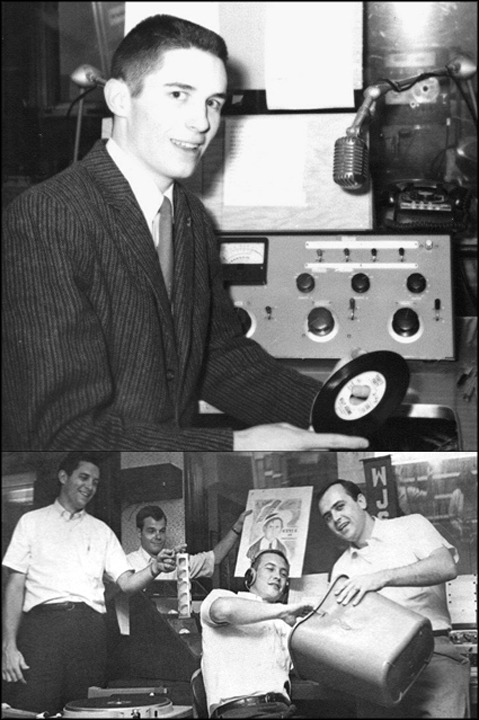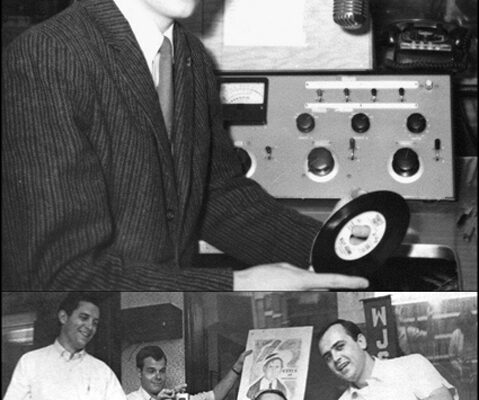Today’s column is an extension of my April 30 WJSO feature story that Don Dale supplied. He also interviewed Ray Stockard and forwarded to me added facts about the once popular station.

Top: Ray Stockard (about 1960);
Bottom (l to r): Ray Stockard, Don Dale, Jack London and Randy Jackson (about 1968)
“I started in radio at ETSC’s campus radio station, WETS, in 1957,” said Ray, “receiving much of my training from Professor Harold Frank. After auditioning for WJSO’s general manager, Bill Bachman, in the fall of 1959, I began working part-time at the station on weekends. About 1960, I was given Norman Thomas, Jr.’s afternoon shift. During that time, Bachman resigned to start his own station in Sumter, South Carolina. Don Sluder went with him. Jim Lewis was hired as sales manager and Bill Harris from Missouri replaced Sluder. A couple other announcers were hired when Bob Mattox left, but I can’t recall their names. Afterwards, others from WETS joined the station that included Eddie Carter, Norm Davis, Hugh Metheny and Don Dale.”
WJSO initiated a new concept in radio when they became the only local station that played a formatted music list of top 40 songs. Such terms as “Top 40 Survey,” “Pick-Hit of the Day” and “Golden Oldies” were virtually unknown then. A record in the top 40 received considerable airplay over “Jayso.” Almost overnight, the station acquired a vast listening audience.
“In the beginning,” said Stockard, “we had to record all our commercials in the control room after we went off the air because we had no recording studio. There were no tape cartridge machines at the time so we used two Ampex 601 reel-to-reel tape recorders for commercials, jingles, news openings and promos. For a couple of years we had a permanent sign-on time at 5:30 am at full-power; there were people who could hear us loud and clear in surrounding states. No one locally had ever broadcast the news like we did with all the effects and using a start time of 55 minutes past the hour.”
About 1960, WJSO applied for an FM frequency. A 100,000 frequency was available and there was much discussion about building an extra room on the back of their building to house the transmitter. However, Norman Thomas, Sr. at the last minute decided not to pursue it because he questioned if FM would survive.
Ray recalled an amusing event during a broadcast day when deejays played the same song over and over. Listeners flooded the phone line inquiring as to what was going on at the station. It seems they were doing a fundraiser for a charity and informed callers that they would switch to other records when they reached their goal. Ray was certain that this clever act of creativity increased listeners.
WJSO was the first local station to play records while broadcasting on-location remote broadcasts. They even had a “hospitality house” built to take to locations such as the annual Appalachian Fair at Gray, Tennessee. Ray recalled doing a remote with a live band performing on the roof of Gregg's Pizza during their grand opening in North Johnson City. The station also did remotes from car dealerships such as the Tennessee Motor Company on W. Market Street.
Stockard commented on WJHL’s name change: “In the middle 1960s, Jim Wilson purchased WJHL AM and FM, changing the AM station to WJCW and the FM one to WQUT. WJSO began to lose listeners in the middle 1970s when FM station listeners began surpassing those on AM stations. FM used stereo and produced a crisper, fuller sound quality than available on AM.”
Ray remained at “Jayso” from 1959 to 1969, leaving to pursue his own station in Lenoir City, Tennessee. However in 1974, he returned to the Tri-Cities area to become the sports anchor on WJHL-TV.
The pioneer broadcaster concluded his comments with Don by saying, “I often wonder where WJSO would be today if the owners had bought the 100,000-watt FM frequency they were considering in the early 1960s.”

Comments are closed.